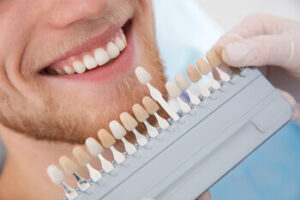Are you uncomfortable with your smile and want to improve it? Dental veneers are an effective way to reshape and whiten teeth, resulting in the stunning smile that you deserve. But before you proceed with this procedure, it’s important to understand what veneers are and the importance of teeth preparation to achieve a perfect result.
In this blog, we’ll explain the definition and purpose of veneers and the significance of preparing your teeth for a successful installation. By the end of this article, you will clearly understand why tooth preparation is crucial for your veneer installation.
What are Veneers?
Dental veneers are thin shells of custom-made materials like porcelain or composite resin. Dentists use veneers to improve the appearance of the teeth by bonding them to the front surface of the existing teeth. Veneers are designed to fit seamlessly into natural teeth and cover imperfections such as discolouration, chips, and gaps. It can also correct minor misalignments and adjustments to the natural teeth.
Why is Tooth Preparation Important?
 To create a natural-looking dental veneer, a tooth must be appropriately prepared to fit it perfectly. It involves removing a small amount of the tooth enamel, which allows the veneer to sit flush against the existing teeth. Once the dentist has removed the tooth enamel, an impression is taken, and temporary dental veneers are placed to protect the teeth.
To create a natural-looking dental veneer, a tooth must be appropriately prepared to fit it perfectly. It involves removing a small amount of the tooth enamel, which allows the veneer to sit flush against the existing teeth. Once the dentist has removed the tooth enamel, an impression is taken, and temporary dental veneers are placed to protect the teeth.
The veneers will fit precisely with tooth preparation, so they look real and natural. Tooth preparation is crucial for successful veneer installation, and it’s part of the dental veneer procedure that can’t be skipped.
Types of Dental Veneers
There are two types of traditional porcelain veneers and composite veneers. Traditional porcelain veneers are the most common type that people are familiar with. They are a durable option that looks natural and provides better stain resistance. However, they are also expensive, requiring at least two visits and multiple rounds of impressions, which are then sent to the dental laboratory. In contrast, composite veneers are less expensive and can be completed in a single dental visit. Composite veneers are made from a tooth-coloured composite resin moulded over the existing teeth.
Teeth Preparation Process
Assessment of Teeth Condition and Necessary Preparations
The first step is assessing the condition of your natural teeth, which includes evaluating the thickness of the enamel, the alignment of your teeth, and your specific desired look. This process usually involves X-rays and moulds of your teeth, which will then be sent to a dental laboratory. From these moulds, custom porcelain veneers will be created. The dentist may also use computer software simulations to show you what the expected outcome of the veneer procedure will look like on your teeth.
 Removal of Enamel From the Surface of Teeth
Removal of Enamel From the Surface of Teeth
The teeth preparation process can begin once the porcelain veneers have been customised and returned to the dentist.
The enamel on the surface of the teeth must be removed as it is necessary to create space for the veneers to be properly placed.
The thickness of the tooth enamel removed is typically less than one millimetre, and a local anaesthetic may be used to numb any sensitivity.
Temporary Veneers Placement
After the removal of tooth enamel, temporary dental veneers will be placed onto the existing teeth until your custom porcelain veneers are ready. Temporary veneers protect the prepared teeth and allow for the proper shaping of the final veneers. These temporary veneers are usually made from a composite resin and are less strong or durable than the final porcelain veneers. This temporary placement can be for a few days or around a couple of weeks, and you need to avoid consuming hard and chewy foods during this time.
Oral Hygiene Routine
Good oral hygiene must be a priority before getting porcelain veneers. A consistent daily routine, including brushing, flossing, and rinsing with an antibacterial mouthwash, can help to reduce the risk of teeth and gum disease. This is essential because if any gum disease or tooth decay issues are present, they can negatively impact the dental veneer procedure. By keeping your natural teeth clean and healthy, you can maintain good overall oral health, allowing the veneers to blend seamlessly.
Veneer Installation Procedure
Removal of Temporary Veneers
Temporary veneers are usually placed on teeth to protect them while the lab prepares the custom-made porcelain veneers. When the dental laboratory sends back the permanent veneers to your dentist, the temporary veneers are removed. Your dentist will examine the teeth to ensure they are in good condition and prepare them for permanent veneers. The tooth enamel will be slightly buffed to create a rough surface to promote bonding with the dental cement.
Placement of Permanent Veneers
The dentist will place the custom-made porcelain veneers on your prepared teeth at this stage. The doctor will check the veneers’ size, shape, and colour to ensure they fit seamlessly with the natural teeth and are aesthetically pleasing. The veneers are bonded to the teeth using dental cement and cured using a special light to harden and secure the veneers.
Final Adjustments and Bite Testing
Once the veneers are securely bonded to the teeth, the dentist will evaluate your bite and make any necessary tweaks to the veneers’ shape and size. They’ll ensure your bite is correct and your mouth is comfortable with the veneers. The dentist will also assess the aesthetics of your new veneers and make any final adjustments necessary to achieve a perfect smile.
Aftercare
Oral Hygiene Routine Modifications
Maintaining proper oral hygiene is crucial, especially after getting porcelain veneers. You’ll need to make some modifications to your dental care routine. Brush your teeth twice daily and floss at least once daily to keep your teeth and gums healthy. Avoid chewing hard objects or foods such as ice, bones, or hard candy. These can cause your veneers to chip or break.
Regular Dental Checkups
Regular dental checkups significantly affect the longevity and appearance of your dental veneers. You should visit a dentist at least every six months to monitor the health of your veneers, teeth, and gums. Your dentist will also check the condition of your veneers and make adjustments or replacements if necessary.
Avoiding Certain Foods and Habits That Can Damage Veneers
While porcelain veneers are quite durable, they can be damaged by certain foods and traditions. Chewing on ice, biting pens or other hard objects, and consuming foods and drinks high in acid content can all increase the risk of damage to your veneers. Additionally, it is best to avoid excessive consumption of tea, coffee, and other staining beverages to maintain the shade of the veneers. Maintaining good dental hygiene and avoiding foods that can compromise the veneers will ultimately extend the lifespan of your new smile.
Post-Installation Concerns
 1. Sensitivity and Discomfort
1. Sensitivity and Discomfort
When you get porcelain veneers, your teeth will undergo some preparation, which involves removing a thin layer of enamel to make room for the veneers. This can cause some sensitivity and discomfort, especially if you have a history of sensitive teeth.
You may experience some sensitivity to hot or cold foods, and your teeth may feel sore for a few days after the procedure. This is normal and can be managed with over-the-counter pain relief medication or sensitivity toothpaste.
2. Chipping or Cracking of Veneers
Porcelain veneers are thin but strong shells bonded to your teeth using dental cement. However, like natural teeth, they can chip or crack if subjected to excessive force or trauma. Avoid biting on hard objects such as ice, pens, and nails, and if you participate in contact sports, wear a mouthguard to protect your veneers. If you notice any chipping or cracking, contact your dentist immediately to assess the damage and determine the appropriate solution.
3. Replacement Options
Porcelain veneers are made to last for a long time, but they may need to be replaced at some point due to wear and tear or damage. If you have traditional porcelain veneers, the replacement process involves the following:
- Removing the existing veneers.
- Re-preparing your teeth.
- Creating new customised veneers in a dental laboratory.
This process can take a few weeks and be costly, depending on the number of veneers you need. However, the replacement process is usually faster and less expensive if you have composite veneers, as the composite resin can be added or removed directly in the dental office.
Conclusion
In conclusion, a perfectly planned tooth preparation is essential for creating the most natural, comfortable, and resilient dental veneer. The dental veneer procedure is a great solution for people looking to improve the appearance of their smile and increase confidence. Consulting with our cosmetic dentists is the first step in creating an individualised dental veneer procedure to match your unique needs and preferences. Contact us on (02) 8806 3799 to schedule your first appointment!
References
A systematic review and meta-analysis of the survival of non-feldspathic porcelain veneers over 5 and 10 years
https://pubmed.ncbi.nlm.nih.gov/23476903/
Veneers
https://www.healthdirect.gov.au/veneers











